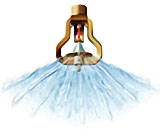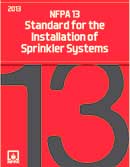 There is a better in good chance that the Globally Harmonized System (GHS) will impact your business. Current fire and building codes are based on NFPA standards, which – in some cases – differ from GHS regulations. With the start of key implementation deadlines already behind us, businesses must be aware of the differences and key requirements between these two sets of regulations in order to successfully adapt to this change. Read more…
There is a better in good chance that the Globally Harmonized System (GHS) will impact your business. Current fire and building codes are based on NFPA standards, which – in some cases – differ from GHS regulations. With the start of key implementation deadlines already behind us, businesses must be aware of the differences and key requirements between these two sets of regulations in order to successfully adapt to this change. Read more…
 NFPA’s Fire Protection Research Foundation hosted this year’s conference on suppression and detection in Orlando, Florida. Presented were the latest research and developments in the fire protection industry that included a diverse cross-section of subjects, such as the effect of ceiling fans on smoke alarm performance, corrosion inhibition of dry and pre-action fire suppression systems, effect of obstructions on ESFR sprinklers, fire suppression in Li-Ion based electric vehicles, and many more. Read more…
NFPA’s Fire Protection Research Foundation hosted this year’s conference on suppression and detection in Orlando, Florida. Presented were the latest research and developments in the fire protection industry that included a diverse cross-section of subjects, such as the effect of ceiling fans on smoke alarm performance, corrosion inhibition of dry and pre-action fire suppression systems, effect of obstructions on ESFR sprinklers, fire suppression in Li-Ion based electric vehicles, and many more. Read more…
 ESFR protection of exposed expanded Group A plastics is currently outside the scope of NFPA 13. Attempting to fill this gap, NFPA’s Fire Protection Research Foundation set out to develop experience with these types of commodities and gather data by initiating large-scale fire tests. The goal of these tests was to evaluate the necessary level of protection when ESFR sprinklers in rack storage configurations with no in-rack sprinkler protection are applied. Read more…
ESFR protection of exposed expanded Group A plastics is currently outside the scope of NFPA 13. Attempting to fill this gap, NFPA’s Fire Protection Research Foundation set out to develop experience with these types of commodities and gather data by initiating large-scale fire tests. The goal of these tests was to evaluate the necessary level of protection when ESFR sprinklers in rack storage configurations with no in-rack sprinkler protection are applied. Read more…
 Polyurethane foam fires are known to produce very high heat release rates and extremely toxic fumes. As a result, these types of fires provide some unique life, firefighter, property safety and fire suppression challenges. In this study polyurethane foam fires and their combustion processes are investigated using the Fire Dynamics Simulator. The software tool’s predictions were validated against test results from experimental burns. Comparisons between simulation and fire tests demonstrated unprecedented good correlation. This formed the foundation of this study validating the model and providing reliable insights into the nature and sequence of the various combustion events taking place. Read more…
Polyurethane foam fires are known to produce very high heat release rates and extremely toxic fumes. As a result, these types of fires provide some unique life, firefighter, property safety and fire suppression challenges. In this study polyurethane foam fires and their combustion processes are investigated using the Fire Dynamics Simulator. The software tool’s predictions were validated against test results from experimental burns. Comparisons between simulation and fire tests demonstrated unprecedented good correlation. This formed the foundation of this study validating the model and providing reliable insights into the nature and sequence of the various combustion events taking place. Read more…
 Klausbruckner & Associates is announcing a new High-Piled Storage seminar for August 20th 2014. This seminar will provide a detailed overview of the latest fire and building code provisions associated with high-piled combustible storage. Discussed will be changes to the 2013 Edition of the California Fire Code (CFC) and potential changes to the 2016 CFC, as well as major changes to the 2013 NFPA 13 and potential changes to the 2016 NFPA 13. Read more…
Klausbruckner & Associates is announcing a new High-Piled Storage seminar for August 20th 2014. This seminar will provide a detailed overview of the latest fire and building code provisions associated with high-piled combustible storage. Discussed will be changes to the 2013 Edition of the California Fire Code (CFC) and potential changes to the 2016 CFC, as well as major changes to the 2013 NFPA 13 and potential changes to the 2016 NFPA 13. Read more…
 The 2013 Edition of NFPA 13 will be adopted by many states and jurisdictions in January 2014. In this article we will be focusing on major changes for this latest edition of NFPA 13 and specifically in the application and use of ESFR (Early Suppression, Fast Response) sprinkler systems. Read more…
The 2013 Edition of NFPA 13 will be adopted by many states and jurisdictions in January 2014. In this article we will be focusing on major changes for this latest edition of NFPA 13 and specifically in the application and use of ESFR (Early Suppression, Fast Response) sprinkler systems. Read more…
 NFPA’s Fire Protection Research Foundation has released a research report on a study of flammability of lithium-ion (Li-ion) batteries in bulk storage. The results of these tests will be used to define appropriate sprinkler protection in NFPA 13 for these types of products. Three types of Li-ion batteries commonly used in various consumer products were chosen for these fire tests. They were stored in rack storage configurations up to 15 ft high. Read more…
NFPA’s Fire Protection Research Foundation has released a research report on a study of flammability of lithium-ion (Li-ion) batteries in bulk storage. The results of these tests will be used to define appropriate sprinkler protection in NFPA 13 for these types of products. Three types of Li-ion batteries commonly used in various consumer products were chosen for these fire tests. They were stored in rack storage configurations up to 15 ft high. Read more…
 How much do you know about fire sprinkler systems? If you are a business or a building owner, an architect, or a member of the construction industry, you may be interested in some of these commonly asked questions on sprinkler protection. Explore with us sprinkler terminology, application and use of various types of sprinkler heads, issues arising from change in occupancy or change in use, solutions to common problems, and some simple ‘rules of thumb’ Read more…
How much do you know about fire sprinkler systems? If you are a business or a building owner, an architect, or a member of the construction industry, you may be interested in some of these commonly asked questions on sprinkler protection. Explore with us sprinkler terminology, application and use of various types of sprinkler heads, issues arising from change in occupancy or change in use, solutions to common problems, and some simple ‘rules of thumb’ Read more…
 NFPA’s Fire Protection Research Foundation is conducting a research project on Lithium-ion battery flammability characterization. The objective of this research is to ‘provide a comparative flammability characterization of common Lithium-ion batteries (as compared) to standard commodities in storage’. This project is part of a multi-phase research effort to develop information for fire protection strategies in Lithium battery storage. Read more…
NFPA’s Fire Protection Research Foundation is conducting a research project on Lithium-ion battery flammability characterization. The objective of this research is to ‘provide a comparative flammability characterization of common Lithium-ion batteries (as compared) to standard commodities in storage’. This project is part of a multi-phase research effort to develop information for fire protection strategies in Lithium battery storage. Read more…
 On June 27 the Research Foundation and NFPA’s international operations department presented a seminar on research to address high challenge storage protection for aerosols, lithium batteries, flammable and combustible liquids, automated storage and retrieval systems, and others. 110 attendees from 17 nations attended this event in Paris, France to explore the latest global research and emerging trends on storage protection. Read more…
On June 27 the Research Foundation and NFPA’s international operations department presented a seminar on research to address high challenge storage protection for aerosols, lithium batteries, flammable and combustible liquids, automated storage and retrieval systems, and others. 110 attendees from 17 nations attended this event in Paris, France to explore the latest global research and emerging trends on storage protection. Read more…
 There is a better in good chance that the Globally Harmonized System (GHS) will impact your business. Current fire and building codes are based on NFPA standards, which – in some cases – differ from GHS regulations. With the start of key implementation deadlines already behind us, businesses must be aware of the differences and key requirements between these two sets of regulations in order to successfully adapt to this change. Read more…
There is a better in good chance that the Globally Harmonized System (GHS) will impact your business. Current fire and building codes are based on NFPA standards, which – in some cases – differ from GHS regulations. With the start of key implementation deadlines already behind us, businesses must be aware of the differences and key requirements between these two sets of regulations in order to successfully adapt to this change. Read more…










